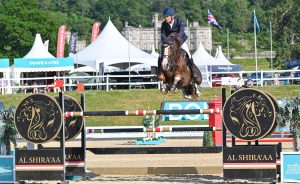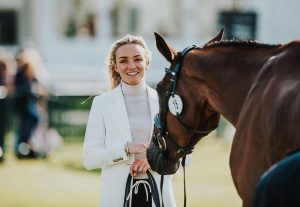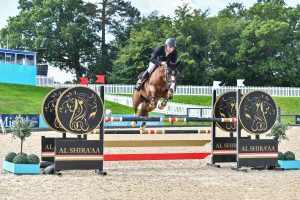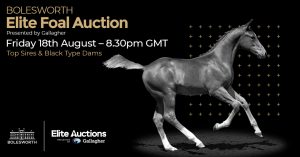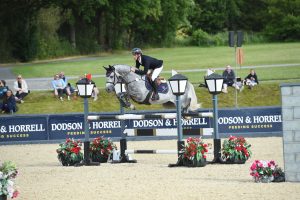




What makes a coloured horse coloured?…a lack of colour!
An explanation of Tobiano and skewbald
TOBIANO (Toh-bee-ah’no) appears to be white with large “spots” (or “patches”) of colour, often overlapping, on animals with a greater percentage of colour than white. Spots of colour, typically, originate from the head, chest, flank and buttuck, often including the tail. Legs are generally white, giving the appearance of a white horse with large or flowing spots of colour. Generally white crosses the centre of the back between the withers and tail.
OVERO (O-vairo) appears to be a coloured (where coloured is meant here to signify any other shade of coat than white) horse with white markings. The spots of white appear to be jagged and originate on the animal’s side or belly, spreading towards the neck, tail, legs and back. The colour (any other shade than white) appears to frame the white spots. An overo often has a dark tail, mane, legs and backline. Faces are often white. Some overos show dark legs with splashy white markings seemingly made up of round lacy white spots. The location of the white never crosses the backline.
Horse Scout has 6 coloured stallions on its lists here is the information, click through to find out more.
1. Solaris Buenno – £500
Homozygous coloured tobiano Scottish Bred Sports Horse
Type – Allrounder, Coloured, Dressage, Jumpers / Show Jumper, Showing, Sports General,
Solaris Buenno, is an interesting addition to the world of warmblood and sport horse breeding .Solaris Buenno is an interesting addition to the world of warmblood and sport horse breeding and an excellent choice for the showing enthusiast. His sire Umenno, has an accomplished performance record to date and his dam Edwina a first premium Supreme Champion mare who`s progeny have already been successful in the county showring.
Buenno, has not only inherited the qualities of both sire and dam but consistantly passes them on to his progeny, elasticity, suppleness, atheleticism, tremendous shoulder reach and powerful hind engine, despite his injury which has prevented him from following an inhand showing and ridden career.
2. Farco Van Vriesput(aka Fab Frankie) £500
16.2hh Belgium Warmblood 2005
Type – Allrounder, Coloured, Dressage, Jumpers / Show Jumper, Showing, Sports General,
About Frankie
Fully Graded and licensed CHAPS and BSPA,gaining 9.5 for jumping ability,conformation,rideability and manners. BSJA Life Approved,almost Grade B and Elite CHAPS.Frankie has an amazing temperament,making him very rideable with great trainability,all of which he passes on to his stock.Frankies bloodline is currently ranked 4th in the world of International Showjumping breeding lines.Frankie is available for AI,both fresh and chilled doses.
3. Moorhey Tomahawk – Lancashire, Lancs -£400
15.2hh Leopard Spotted Appaluosa
A true all round Sports Horse Stallion this compact stallion has it all. He has the most fantastic temperament, drop dead gorgeous looks & perfect conformation. To add to all that he has successes in Showing, Sports horse Classes, young Event Horse Classes, BSJA Show jumping & BD Dressage. He is the proven sire of a HOYS winner, numerous Showing & Sports Horse Champions, as well as Show jumpers & Dressage horses.Show Jumping He has substantial BSJA winnings showing a superb technique over a fence which he passes onto all his offspring. He is both bold & careful with plenty of scope. Dressage He has almost 200 Bd points winning at Elementary level. Last year he was 4th at the Nationall & won the Individual Elementary Section at the BD Home Internationals at Rowellan. Sports Horse As both a 4 & 5year old he won numerous Ridden Sports Horse Classes & qualified for the Burghley young Event Horse Final at Burhgley. Showing Numerous Ridden & In Hand Championships,to his name
4. Country Colour Spot – Lancashire, Lancs
12.2 Part Bred Arab Homozygous Bay Tobiano
Licensed PBA Graded BSPA BSJA Assesed
A super Sports/Show Pony Sire & being Homozygous guaranteed to throw a coloured foal to any colur of mare. Being by our own Spotswood Jafeica, he has inherited his father’s superb temperament, great attitude to work & is just a star to do anything with. His paces are superb, with a lovely elevated floating movement & a natural uphill ride. Qualified RIHS ridden coloured on first outing. He has his sire’s natural aptitude to jumping, he passed his BSJA assessment with flying colours & is now showing his huge scopey jump in the ring. BSJA winnings with Double clear in Stepping Stones & British Novice ridden by a 10year old girl. He won Nursery stakes Working Hunter at Winter Festival of Champions, his first ever Working Hunter class. He is proving to be an absolute star taking everything we throw at him in his stride. This pony is an absolute dream to do anything with, he has a great personality, loves to work & please & is fantastic with the smallest jockey. Qualified RIHS Ridden Coloured on first outing under saddle 2011 Won Nursery Stakes championship at Spring Festival of Showing in first WH Class BSJA winnings with double clears in Stepping Stones.
5. Country Top Dollar – Lancashire, Lancs £570
16.2 Bay Tobiano TB X Dressage Stallion
This stallion has inherited his sire’s elegant looks & famous temperament. He is a true Ridding horse stamp, full of quality & presence but given his Dam’s achievements & family history also full of jumping ability. His elegant looks & paces have made him a top show horse & successful dressage horse but his ability over a fence & his breeding make him too good to just keep on the flat! He is by our one & only ‘Country Top Gun’ & as with his sire he is a true thoroughbred with pure quality, he is one of the most elegant coloured horses around & he is even more stunning in the flesh.
Country Top Gun – Lancashire, Lancs £600
Coloured16.2hh Anglo European Grade B Jumping Stallion
One of the best known & most proven coloured stallions in the country. Imported from Ireland as a foal, his Top Class blood lines go back to both sets of grandparents. He has produced over 80% coloured foals. Country Top Gun has Top Show Horses, Show Jumpers & National Hunt Horses in his pedigree which includes Prefairy & goes back to the legendery Precipitation. His Sire Stensen is the sire of many top class coloured competition & Show horses. His full sister Pauldary’s Lady Aaddie is a prolific winner in the show ring.
6. Umenno – Braco, Perthshire £700
16.1hh Chestnur Tobiano KWPN / Dutch Warmblood
Umenno possesses a good trainable temperament, powerful flamboyant movement, a beautifully marked chestnut and white robe, and a pedigree of legendary ancestry with 50% thoroughbred. Bred with athleticism in mind Umenno is an expressive powerful mover with off the floor paces and has demonstrated good jumping ability in the showjumping arena.Umenno was also shown in hand throughout the UK, standing Open Non Native National Champion and young stock reserve. He has stood Champion at many National county shows including, the Scottish Chaps National, the Highland Show, Fife Show, and Great Yorkshire along with other wins in Sport Horse classes.As a four year old he jumped double clears in British Novice. Discovery and Newcomers. He qualified for the Royal Show potential showjumper, the Royal International Horse Show BSPA Ridden finals, Burghley young event horse, Arena UK 4 year old SJ championship, and the Scottish Sports Horse 4 year old showjumping sport horse series along with numerous overall Championships in ridden sport horse classes often standing vainquer to older competitors. Winner of the five year classes at Bicton and the six year old class in St Legier Switzerland with additional placings at RII with Rudi Wallerbosch.Umenno has since been sold to South Africa and has dominated the showing circuit with multiple wins and Championships.Frozen semen is still available for distribution within all EU countries, Australia, New Zealand, Canada and the USA.

